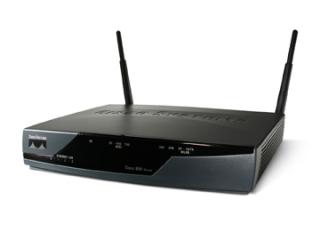As part of my ongoing attempt to simplify my IT infrastructure at home I recently decided to replace my NetBSD firewall and the external DSL modem with a router appliance. The list of advantages was long:
- Less noise and power consumption, the firewall was a SPARCstation 20.
- One less UN*X system to look after.
- Less power bricks under my desk.
- No more MTU problems caused by PPPoA to PPPoE bridging.
- More reliable (than the Linksys DSL modem).
Unfortunately my requirement list for a DSL router was long:
- Normal routing for public IP address
- NAT for non-public IP address
- IPv6 support
- IPsec VPN support
- Flexible packet filter rules
- Proper administration interface
- SNMP support (for MRTG)
- Configuration file backup and restore
- ADSL 2+ support (for future use)
I searched the web for possible candidates and found exactly one: the Cisco 877W.

I was not to happy about this because my previous jobs taught me that Cisco equipment can cause a lot of trouble:
- The IOS version that is installed on your Cisco never supports all the features you need.
- The IOS version which supports all those features requires more memory and/or a larger flash card than your Cisco is equipped with.
- At least a part of the necessary configuration will be completely unobvious and you have to search the web or ask arround to figure it out.
- You will reach a point where it seems to work. Just when you enjoy your success it will break horribly.
- Cisco will not allow you to download a firmware update without a support contract even if it fixes a critical security hole.
I bought a Cisco 877W (with an extra 802.11g WLAN option) nevertheless. And of course things went wrong:
- Despite being advertised as supporting IPv6 it did not.
- The IOS version with IPv6 support required a larger flash card.
- The first flash card upgrade I received was broken. I didn’t realized that immediately of course but spent hours figuring out why format flash: wasn’t working.
- Configuring the DSL connection on the 877W is tricky. You can’t simply take the obvious approach and use the ATM interface. You need to create a Dialer interface (sounds archaic, doesn’t it?) and tell that to use the ATM interface for “dialing” out. Fortunately Google found a useful example configuration.
- When I finally got the Cisco working as a router (with the NetBSD firewall still providing packet filtering and NAT) I was pleased. But 10 minutes later the DSL connection went down. It happened again and again until I finally had to switch back to the Linksys DSL modem. Before I did that my Internet link wasn’t even stable enough to search the web for a solution. I posted a question to the Usenet and got a lot of unhelpful comments suggesting that my phone line was probably bad. Finally somebody pointed out to that Cisco is distributing firmware updates for the builtin DSL modem of the 877W on their public FTP server. I installed version 3.0.10 of the firmware,connect the phone line to the Cisco again and this time it really worked fine.
But getting basic routing functionality working was of course only half the story. I still needed to write Cisco IOS packet filter rules (for IPv4 and IPv6) and get NAT working. I had to postpone doing that several times mostly because of problems with the backup mail server for my domains. Last Friday I finally managed to write the IPv4 packet filter rules despite spending most of the day on maintenance of that backup mail server. On Saturday I found time to write the IPv6 rules, After a nice relaxing walk through the Botanic Garden I got NAT working on Sunday.
Now it was time to put the old firewall out of operation. My wife and I removed a stack of old hardware first:

The old Wireless Access Point had to stay because the IOS version currently installed on my Cisco 877W doesn’t support bridging IPv6 for some weird reason. There is a IOS version which does but who knows how to get it.
We set up the Cisco, connected all the cables and powered the router up. For some unknown reasons the universe showed mercy and everything just worked fine without further problems. It has worked fine ever since and I’m still enjoying The Silence of the Packets because the SPARCstation 20 is no longer making a lot of noise.

I wish i’d found this post before i’d shelled out for an 877w!! Grrr, i bought it specifically because it was advertised as supporting IPv6… 5 days into working out how to configure it, not being able to find the IPv6 config commands then coming across your post has really really put me in a bad mood with Cisco. I remember now why i vowed to never use cisco products ever again back in 2000. Wish i’d stuck to that. If i don’t get a refund on this router i’ll be taking Cisco to court for wasting my time.
Yes, the advertisements for the 877W are usually misleading. I’ve complained about that and got the Advanced IP Services update withot a shipping charge.
Hi, I currently have a 1721 with a wic1adsl which has worked without problems for a few years.
It has a tunnel defined which was also with btexact but has stopped.
I also have an 877 without wifi, but the image is only ipv4.
Did your v6 image come with the router or via another means?
Like you, I don’t have access to cisco to download one.
Regards,
Andrew.
I had to buy the “Advanced IP Services” feature set to get IOS support for my Cisco 877W.
As this image is larger than the normal IOS image I had to upgrade the flash of the machine as well as mentioned in the article.